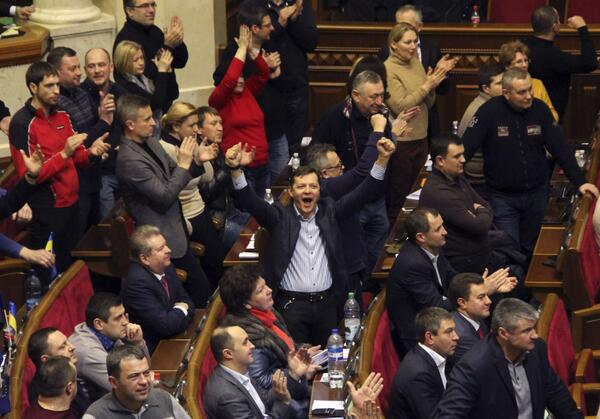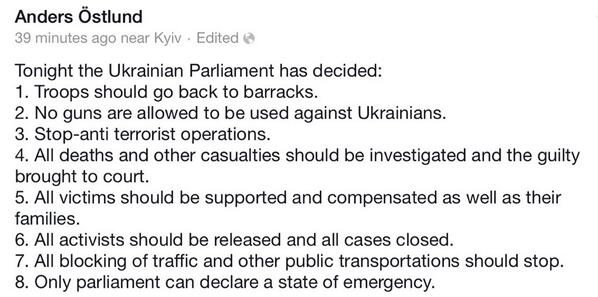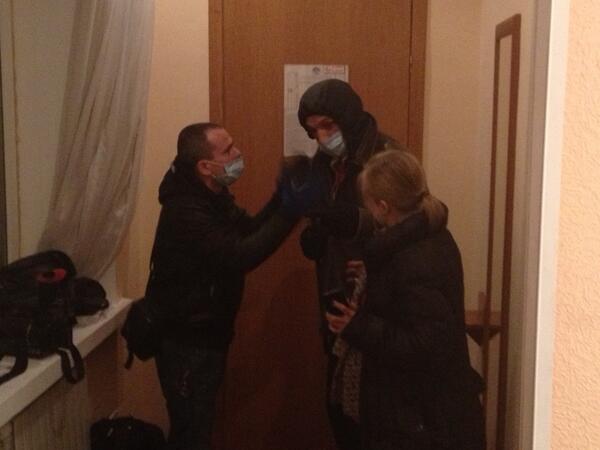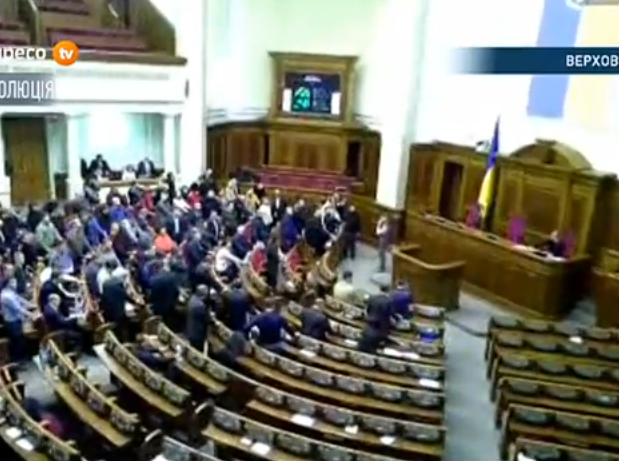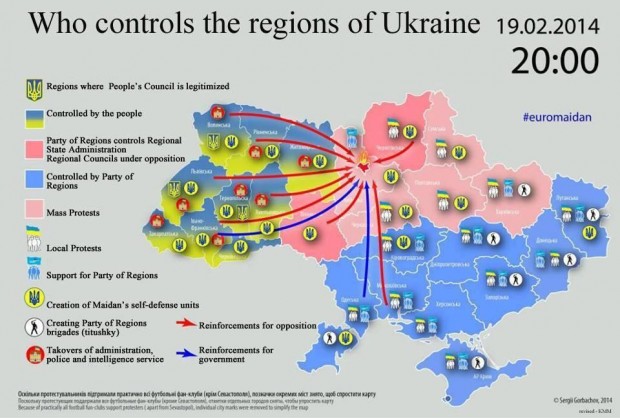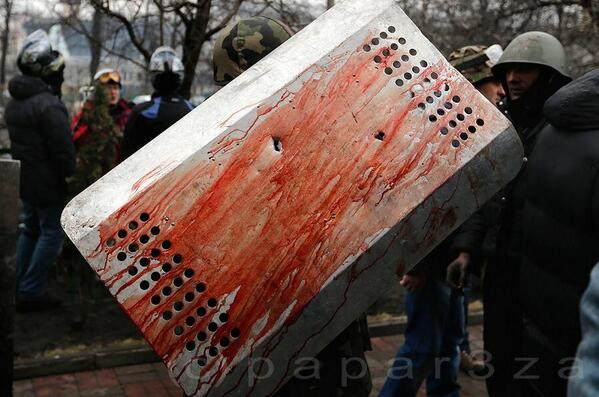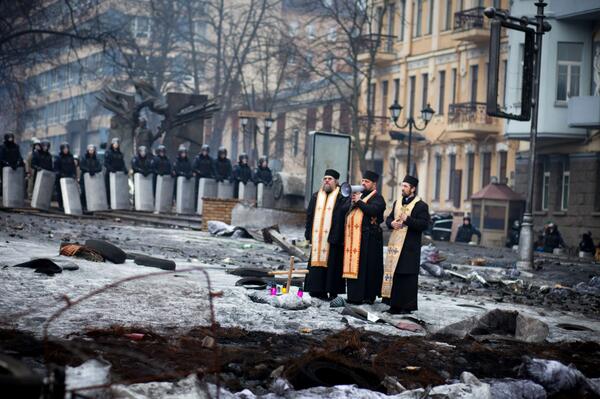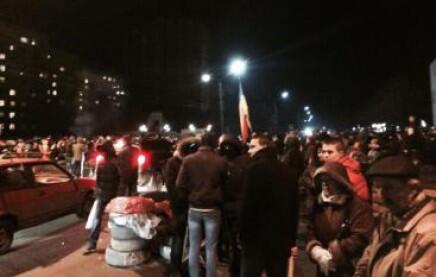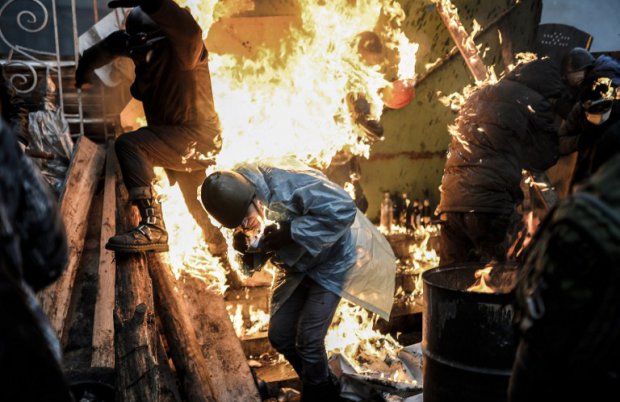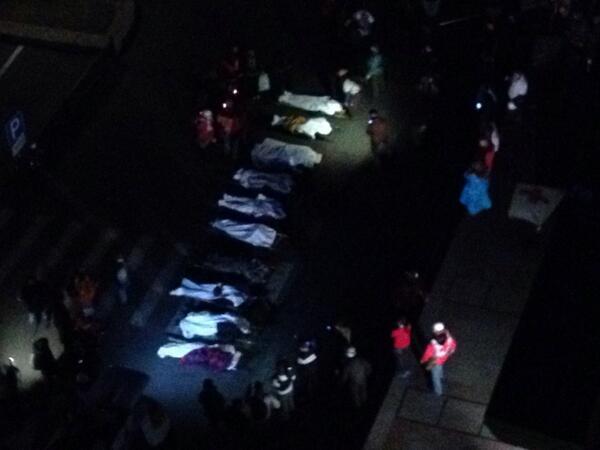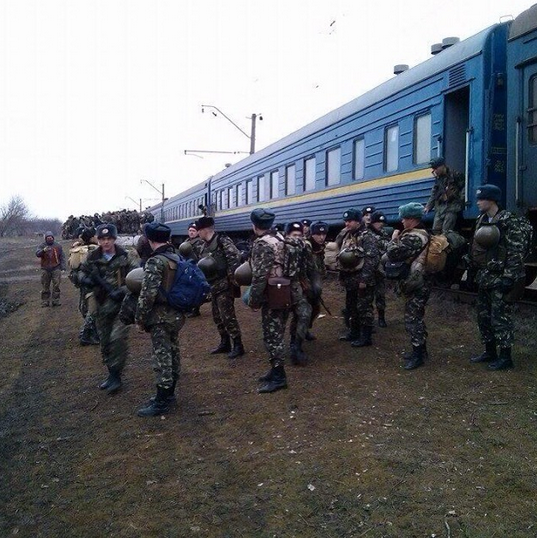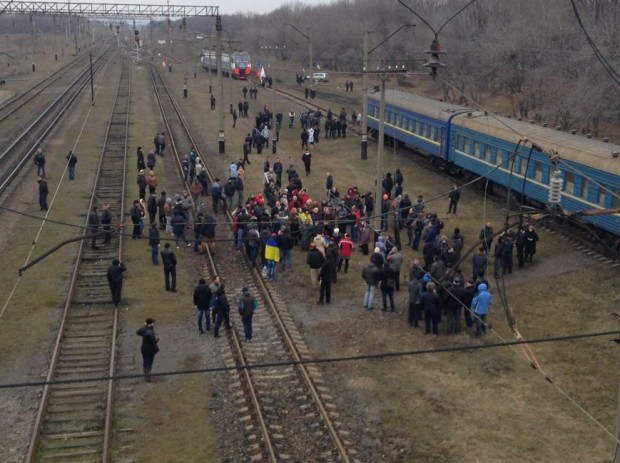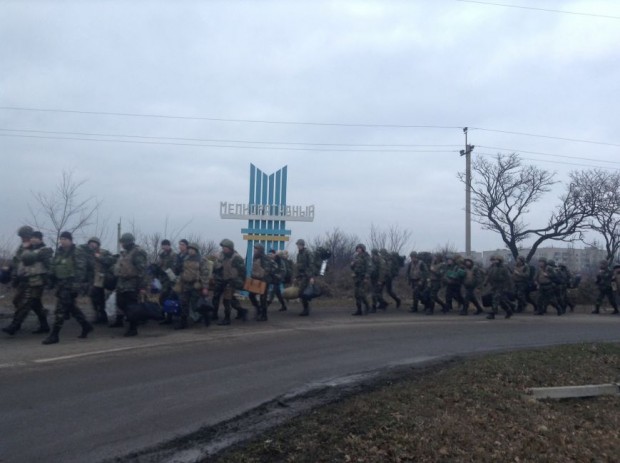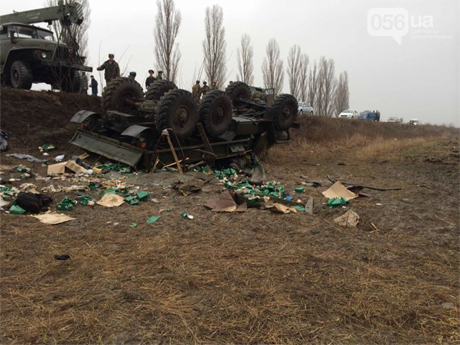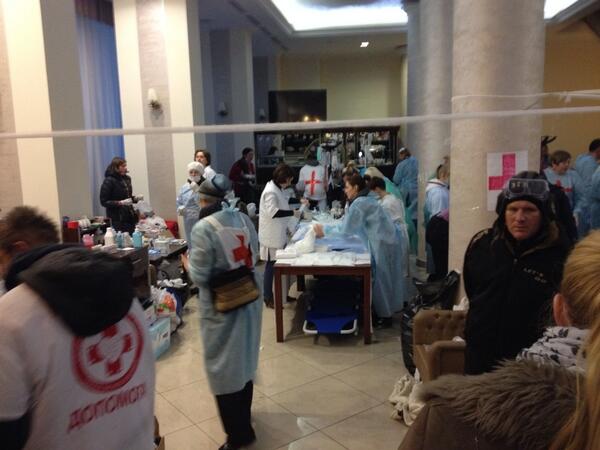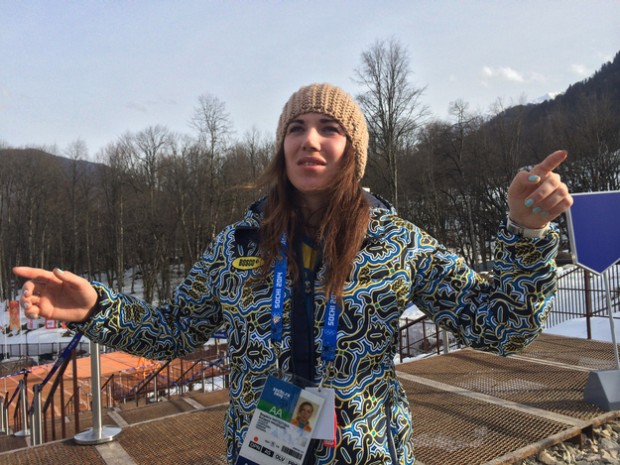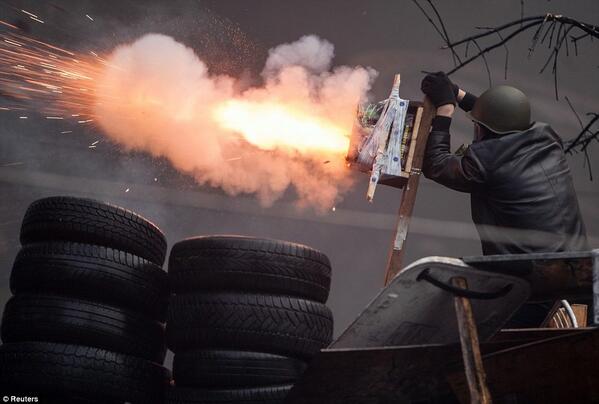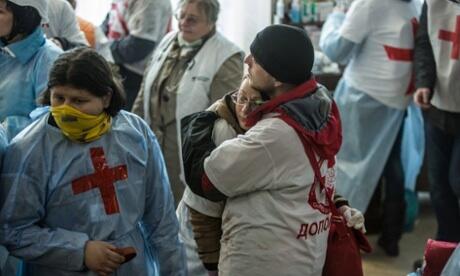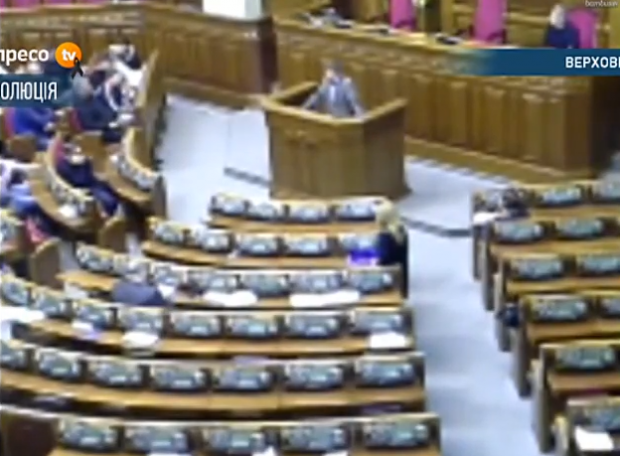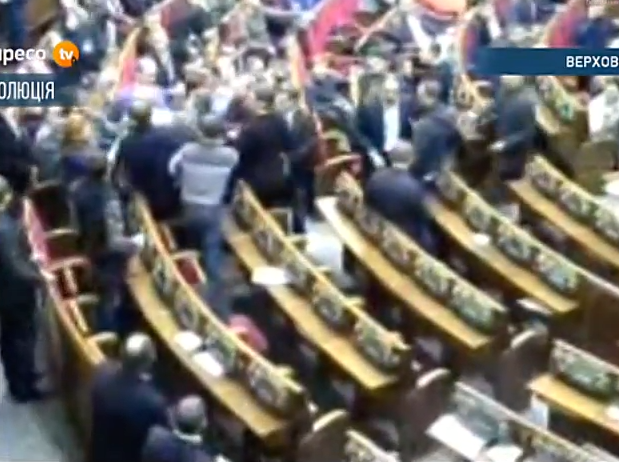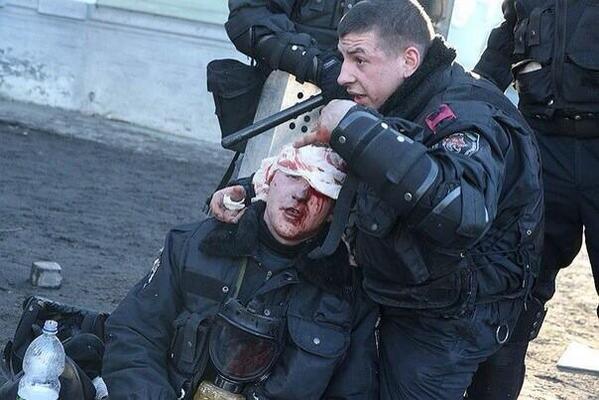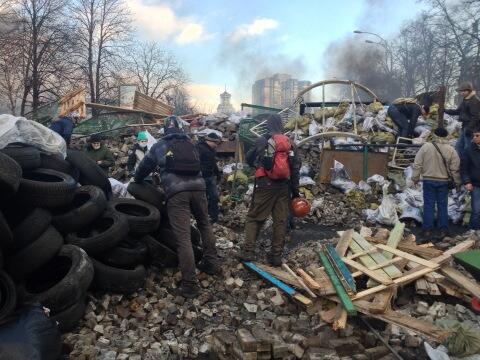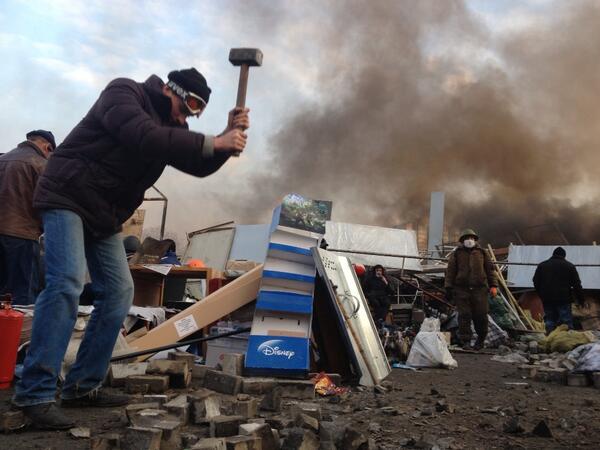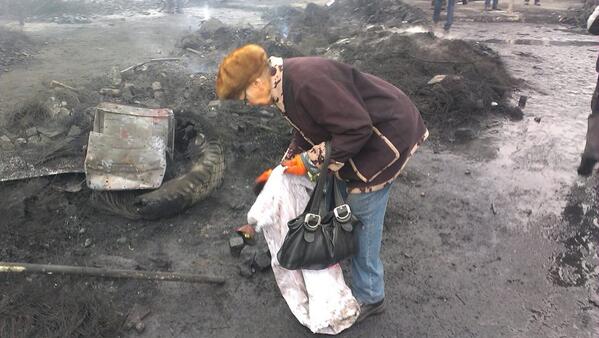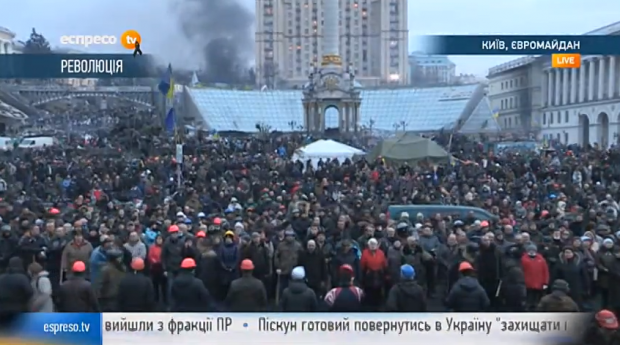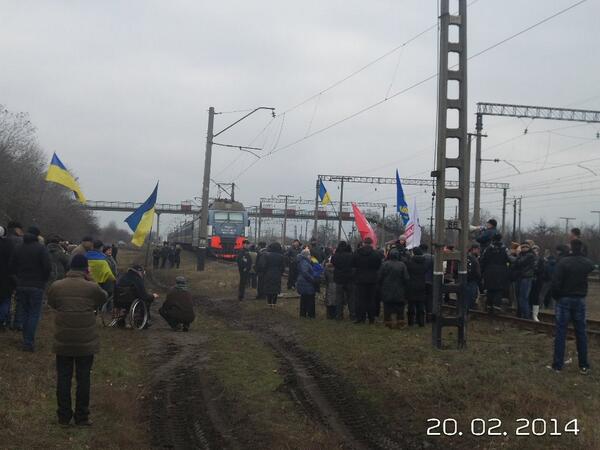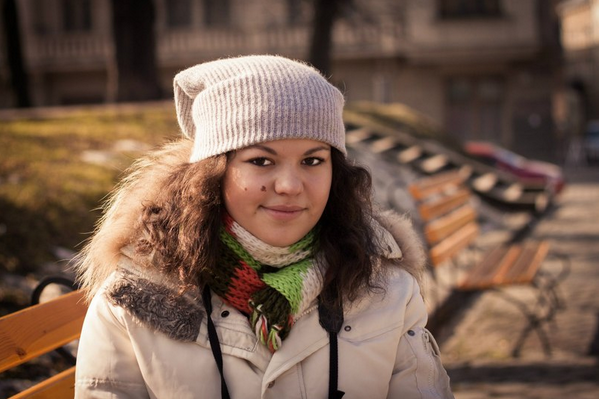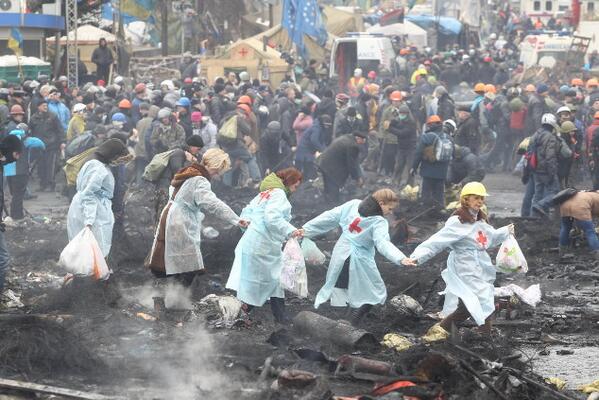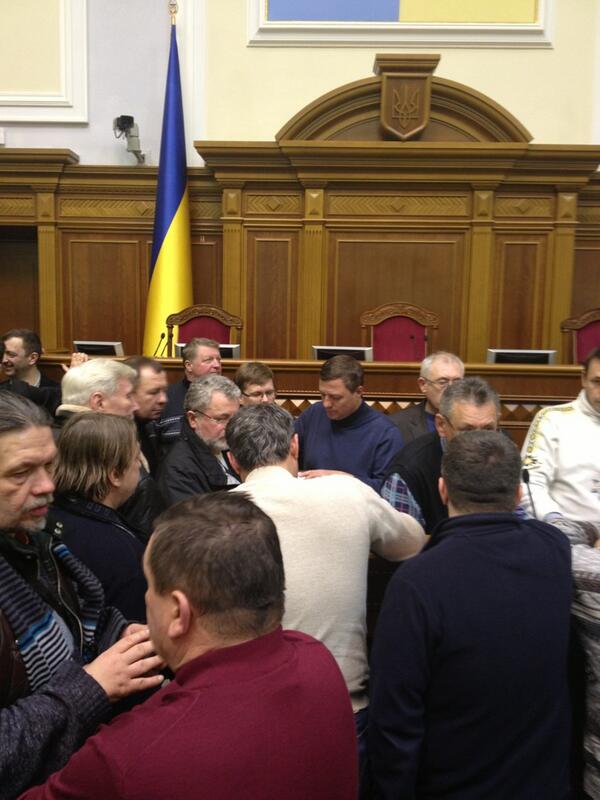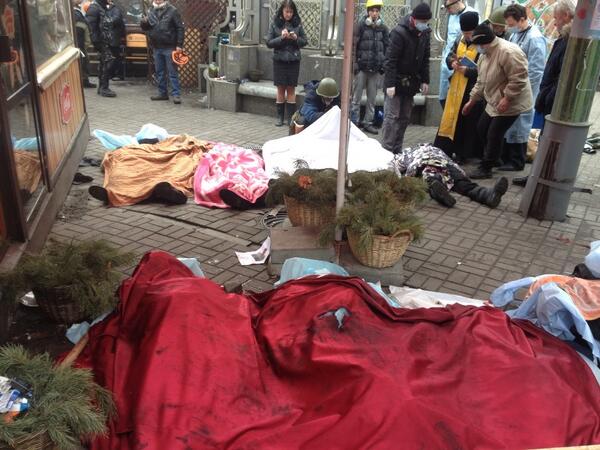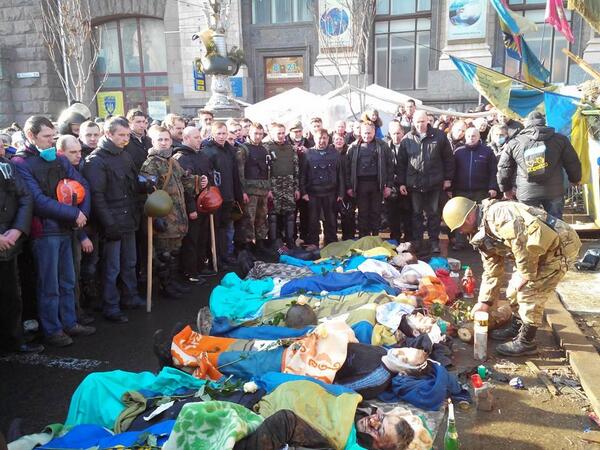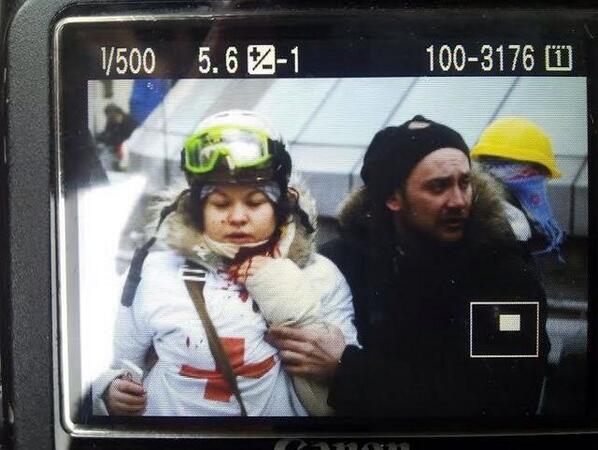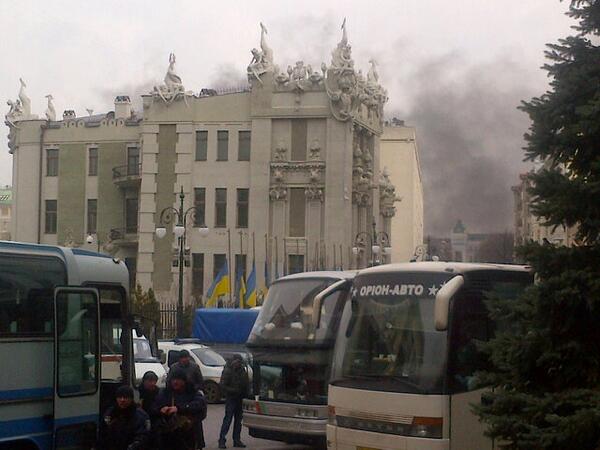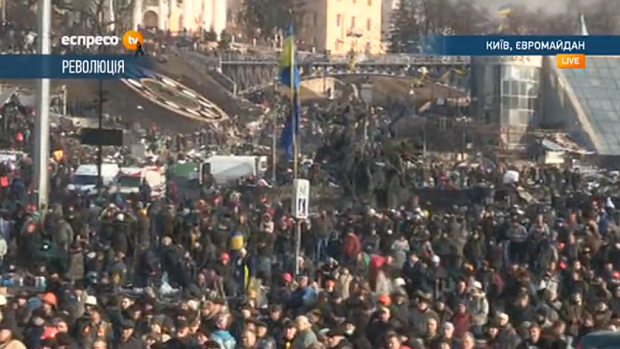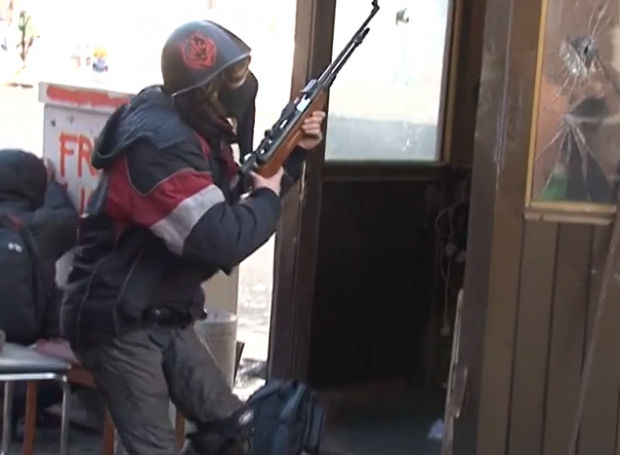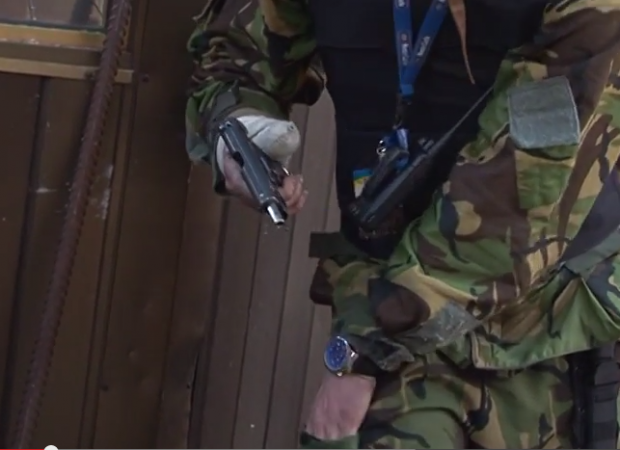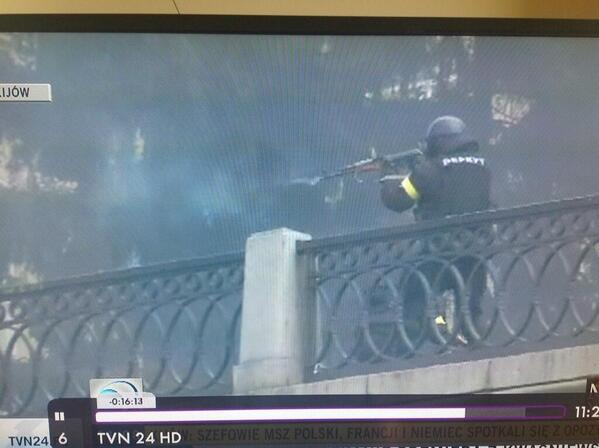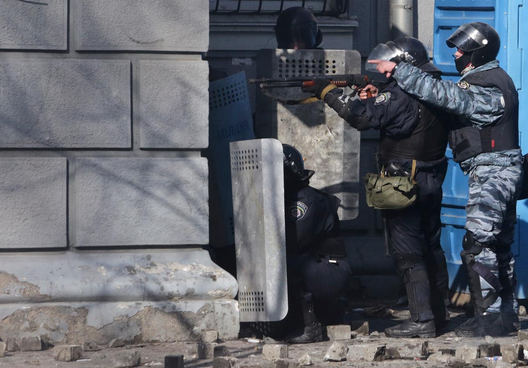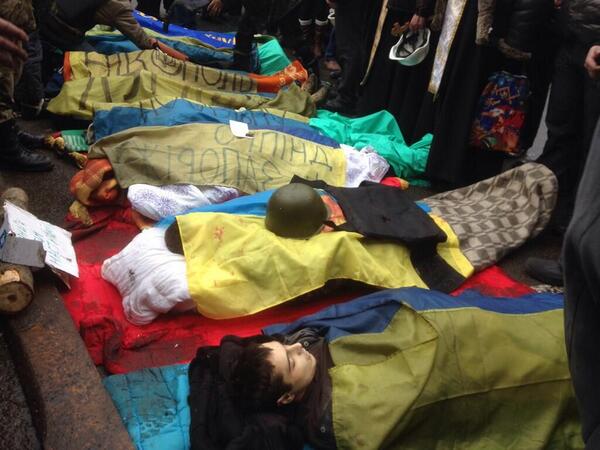The tenuous “truce” brokered yesterday between the government of Ukrainian President Viktor Yanukoyvch and the Euromaidan opposition appears to be fallen apart already. Paramilitary titushki thugs still roams the streets armed with guns, snipers have again been spotted, dozens of activists have been reported killed, and scores injured protesters are being treated in makeshift field hospitals. There is now another allegation that a Russian Spetsnaz (special forces) officer has been “captured” by Euromaidan protestors and hauled onto stage, with his martial insignia as evidence that the Kremlin has already sent military forces in to quash the months-long rebellion.
CLICK HERE TO JUMP TO UPDATES – Here is the latest summary of today’s events.
If you’re just tuning in to Ukraine, our podcast covers the basic questions – what is happening, why are people protesting, and what does this have to do with Russia?
Yesterday’s liveblog can be found here. For a summary of the first 24 hours of events in Ukraine, see our translation, What Happened Overnight in Kiev and Throughout Ukraine.
Here is a livestream of the events:
Updates are below. Refresh the page, as we make regular updates:
2215 GMT: Right now there are two stories that deserve far more press attention than they are getting. This first is the story we’ve covered in recent updates. The Ukrainian parliament, or Rada, has been meeting all day. However, most of those present were members of the opposition parties. In fact, there were many reports that many MPs from the President’s Party of Regions had fled the country. Regardless, they were not present at the Rada session.
At the last minute, however, several more members of the Rada showed up. With 34 members of the Party of Regions present, the Rada had a quorum, and could legally pass laws.
And they did — banning the military actions of the police, and declaring that all protesters were to immediately be released from prison. (jump to update 2119). Furthermore, tomorrow morning the Rada could vote to revert to the 2004 constitution that was the result of the Orange Revolution.
Of course, this isn’t about legalities. No one expects the riot police to be pulled off the streets because of laws. In fact, these are not even laws yet, as the President would have to sign them. If the President does not sign them, they would go back to the Rada, but it would take some time, and by then the President’s MPs would likely be in place to block the votes.
This is about the image — the image of a half-empty Rada, where only the opposition MPs and those who defected to them stayed to come up with solutions. In fact, large numbers of Yanukovych’s camp have either defected, resigned, or deserted. Yanukovych’s political support is crumbling by the minute, and what happened in the Rada is the surest sign that this aspect of the story will be making headlines tomorrow.
Photo: Ukrainian opposition members celebrate during the voting in parliament in Kiev (Reuters) pic.twitter.com/vICDRPUeiZ
— AJAM Live (@ajamlive) February 20, 2014
All of this brings me to the second under-covered story of the day. Earlier today Ukraine’s own Ministry of Foreign Affairs posted an extremely conciliatory statement, one that even said that
-
Ukraine should enter into agreement with the European Union
(jump to update 1844). This is the central demand of the first EuroMaidan protests, the key issue at play, and a major difference with the official position of the President.
What happened? It’s not clear, but it’s another sign that Yanukovych doesn’t even have full control of his own government, forget about the streets of Ukraine.
2134 GMT: The Russian Foreign Ministry has slammed the “West” and the Maidan “radicals” but has offered to “help” the country of Ukraine:
Russia will extend its helping hand to Ukraine in an effort to normalize the situation in the country, which has been rocked by riots, to the extent welcomed by Kiev, a deputy Russian foreign minister said Thursday after returning from the Ukrainian capital.
“Let’s hope that our Ukrainian friends and partners, brothers will normalize the situation at last,” Grigory Karasin said. “We will help that to the extent our Ukrainian partners want.”
2119 GMT: Here is the (unofficial) list of at least some of the things that the runaway (but legal) session of Rada has decided tonight:
This reads like a setup for Cromwell vs. Charles I
Ukraine's parliament tonight.
Thx @andersostlund for a brief pic.twitter.com/UJn7leFxps
— Paul Stiles (@MTstiles) February 20, 2014
Here are the important parts of this — all anti-riot activity at this point is illegal, and the President, by not having the power to declare a state of emergency, may be unable to stop this.
The question is whether the police, or Yanukovych, will abide by these laws. So far, Yanukovych’s political powerhouse seems to be eroding, nay, crumbling, at a pace that does not bode well for his political survival. If the members of his Party of Regions really have fled the country, and do not show up to vote tomorrow, then Yanukovych, without an election, may find his own legal authority effectively pulled from underneath his feet.
2112 GMT: The parliament has decided not to vote on returning to the 2004 constitution tonight. It’s unclear what they have decided, however.
#Ukraine's Parliament has not voted for restoration of 2004 Constitution, but will open tomorrow at 10 to work again
— Natalia S. (@tanais_ua) February 20, 2014
This is a major oversight by the Yanukovych camp. We’re not sure yet what exactly is being agreed upon, but Yanuykovych may soon have no power — except the power to operate illegally.
2045 GMT: More information on the Rada vote to end the military crackdown on protesters across the country:
The #Ukraine Parliament just voted for a full demilitarization of the country, ordering all forces to return to their bases immediately.
— Chrystyna Lapychak (@chryslap) February 20, 2014
The chamber was almost half empty, but still got the 236 for a majority (Rada as 442 seats, so margin of what, 15.). It is legit.
— Roland Oliphant (@RolandOliphant) February 20, 2014
34 Deputies from Yanukovych party voted with opposition in Parliament @aavst: 34 депутата от партии Регионов голосуют вместе с оппозицией
— Hannah Thoburn (@HannahThoburn) February 20, 2014
In other words, there were enough MP’s present to have an official vote, and it’s possible that the only members of the Party of Regions, Yanukovych’s party, who were present voted for the resolution.
But there is more information on the Rada, which is still in session:
The 239 MPs present at Ukr. parliament session looks set to elect new speaker. The current one, Rybak, seems to have fled country.
— Hannah Thoburn (@HannahThoburn) February 20, 2014
.@EspresoTV reporting that Ukr parliament is about to take up question of returning to the 2004 constitution.
— Hannah Thoburn (@HannahThoburn) February 20, 2014
In other words, Yanukovych now not only has a major crisis on the streets, he’s about to have a constitutional crisis, as his own party has not showed up to the Rada, but the Rada is legally capable of making policy without them.
2036 GMT: There is a soft confirmation that Yanukovych told European Union foreign ministers that he was willing to hold early elections, according to US ambassador to Ukraine, Geoffrey Pyatt:
“There’s a lot of discussion this evening about early elections, and I understand that there were some suggestions made by Yanukovych to the three visiting European foreign ministers who were here,” Pyatt said on the phone from Kiev, referring to the visit of the French, German, and Polish foreign ministers to the Ukrainian capital.
“Our position is the President Yankukovych needs to lead his country into a new future, and he needs to do so through the vehicle of a new government, change to the constitution and the political order.”
2027 GMT: The Rada has closed their session and erupted into song, singing the National Anthem. As we’ve been reporting, Yanukovych’s own party has not attended. Now, here is what they voted for:
Parliament of Ukraine voted resolution to stop military actions and release hostages. Singing national anthem
— Site Maidanua.org_en (@sitemaidan_eng) February 20, 2014
2022 GMT: A disturbing claim:
2 protesters are going from room to room saying they're searching for a sniper in the #Ukraine Hotel. #Kiev pic.twitter.com/x4dDV7o2PR
— Duncan Crawford (@_DuncanC) February 20, 2014
2015 GMT: The Rada is still meeting, but once again it’s almost all the opposition candidates, not Yanukovych’s own Party of Regions, present:
239 MPs registered in Rada at emergency session, quorum secured. Vice-speaker Koshulynsky presides, not speaker #Rybak who reportedly fled
— Myroslava Petsa (@myroslavapetsa) February 20, 2014
1955 GMT: The Interior Ministry has admitted what we’ve known all day, that police have used live rounds to suppress protests :
Ukraine Interior Ministry admits that its troops used live rounds to shoot at protestors on Thursday: https://t.co/k4UqeKIWJT
— Simon Shuster (@shustry) February 20, 2014
Amnesty International’s Bogdan Ovcharuk, who is in Ukraine, has spoken to a doctor who says it’s much worse than that — the police were clearly and deliberately trying to kill:
Snipers fire for effect, targeting heart, brain, carotid artery. People have no chances to stay alive. – Dr Bohomolets #EuroMaydan
— Bogdan Ovcharuk (@goddan) February 20, 2014
Actions of titushki,colluded with police, paid by gov vigilante groups -in blind spot for regime.They are alleged to be resp for many deaths
— Bogdan Ovcharuk (@goddan) February 20, 2014
1945 GMT: This map offers a helpful overview of what’s happening outside Kiev. However, as pro-Yanukovych forces are already pulling back in some regions due to growing pressure at home, the map is already out of date:
Who controls the regions of #Ukraine #euromaidan pic.twitter.com/9zU3l5yKMm
— Sean Guillory (@seansrussiablog) February 20, 2014
1936 GMT: Several pictures from earlier today help tell the tale of what happened. The first shows protesters, one of whom holds a shield that was likely captured in the last few days from riot police:
Blood soaked shield with bullet holes in it.#euromaidan pic.twitter.com/ervnrlt8w2
— ЄВРОМАЙДАН (@euromaidan) February 20, 2014
The next shows priests standing between protesters and police:
Our boys. #Priest prays between police & protesters in #Ukraine. Nearly 70 people have died today in the violence pic.twitter.com/acO8qKfXFi”
— Kevin M. Young (@MilaneseCanon) February 20, 2014
But the peacemakers may not come out on top. The atmosphere in Ukraine is more angry and divided than ever:
#Euromaidan, no longer shout "Out with the bandit", but "Death to the bandit". новая речевка на Майдане – не "Зека-геть" а "Зеку-смерть"
— Katya Gorchinskaya (@kgorchinskaya) February 20, 2014
1919 GMT: We’ve been reporting today that, according to several sources, many members of Yanukovych’s party have fled the country. This is also evidenced by the fact that the Rada (parliament) is mostly empty, and appears to largely be devoid of Yanukovych’s supporters.
Now this:
According to @ShulgaVP there are usually 80 flights out of Zhulany airport daily. Today there are 180 charter flights 2 Dnsk and EU pls RT
— Vasyl Pawlowsky (@uamuzik) February 20, 2014
The charter flights, the theory goes, are due to wealthy and powerful politicians and businessmen fleeing the country. Now there are also reports that protesters are trying to halt people from leaving the country:
People are blocking the airport Boryspil to stop deputies and officials escape from #Ukraine #euromaidan pic.twitter.com/iryVqPdkUT
— Oleksandr Akymenko (@akymenko_o) February 20, 2014
1904 GMT: In order to defend against the threat of Euromaidan protesters, a new political front (with plenty of thugs at their disposal) was created called the “Ukrainian Front.” Here’s an excerpt from a report on that group’s formation:
This new organization, called the Ukrainian Front (Украинский фронт), aims to “save” Ukraine from foreign meddling and revolution, and has just been established in Kharkiv, Ukraine’s second-largest city, under the “grassroots” auspices of Yanukovych’s ruling Party of Regions. Harking back to the Second World War and the Stalinist era, the article cites the stirring words of Mykhaylo Dobkin, one of Yanukovych’s top functionaries in Kharkiv and a prime mover behind the front’s establishment: ”After seventy years a new Ukrainian Front is starting to operate in Ukraine, the members of which will follow the example of our fathers and grandfathers and free our land, like in the 1940′s.”
Today, out of fears of collapsing support for Yanukovych in the eastern Kharkiv Oblast, fighters from the Ukrainian Front will be headed by to their base instead of joining pro-Yanukovych forces in Kiev. Ukrainskaya Pravda reports
The chairman of the Kharkiv Regional Government, Mikhail Dobkin announced that activists from the “Ukrainian Front” are turning back from Kiev to Kharkiv.
“Activists from the Ukrainian Front, who have been heading out from Kharkiv to Kiev to help restore order over the last seven days, are returning on my command today. Firearms are being used against civilians and police there, and we have no right to risk people’s lives.” said Dobkin.
According to him, after their return, the activists will join the ranks of the regional defense force.
“We have no other choice. It’s impossible to withdraw the army to defend our territory. The police force is depleted. We have no other option left but to organise ourselves” said the chairman.
1857 GMT: A possible major concession:
#BREAKING: Yanukovych told EU envoys willing to hold early elections: Polish PM
— Agence France-Presse (@AFP) February 20, 2014
1844 GMT: This statement from Ukraine’s Ministry of Foreign Affairs is striking. Perhaps most striking is how different it is from statements made by the President and from the actions of Ukraine’s police and armed forces on the street. We are putting the full statement here:
At the time when the eyes of the world are turned to Ukraine, when our brothers and sisters lose their lives on the streets of Ukrainian cities, Ukrainian diplomats cannot stay aside.
Under these conditions, our primary mission is a true and impartial informing the international community about the situation in our country, as well as protection of national interests of Ukraine, the Ukrainian people, and each and every Ukrainian citizen.
We have always been and will be guided by the basic principles – independence of Ukraine, safeguarding through diplomatic means its sovereignty and territorial integrity. Therefore we cannot but respond to some statements coming both from inside and outside of Ukraine about a possible split of our country. We strongly condemn such statements and express our utmost support for Ukraine as a single, unitary, and European State.
We believe that now is the time for compromise. We urge all parties to do everything to ensure that our country has ceased the bloodshed.
When the conflict is still underway, remember that the common European values unite Ukrainian citizens with each other. We believe that the signing of the Ukraine-EU Association Agreement, the support of which has in fact become a cornerstone for Euromaidan, can unite us all.
1835 GMT: It’s one of the most amazing pictures taken yet in Kiev – the AFP photographer. Bulent Kilic, who took the picture, has told his story of this, and many other pictures he has taken. Read it here.
1830 GMT: The European Union has passed sanctions against Ukraine for “violence and excessive force.”
Swedish Foreign Minister Carl Bildt tweeted that asset freezes and travel bans would be adopted “as a matter of urgency”.
1825 GMT: A list of the names of 58 people killed today has been published on Facebook. Obviously we can’t confirm the list yet, but if 58 names have been confirmed, it’s a safe bet that more than these have been killed.
1820 GMT: The bodies are now literally being lined up in the streets:
They are bringing the bodies out of my hotel pic.twitter.com/hjDHjOlQIM
— Daniel Sandford (@BBCDanielS) February 20, 2014
1753 GMT: Earlier we reported that a train full of troops was being blocked by protesters (jump to picture at update 1513). This picture reportedly shows the troops getting off the train and walking:
This gallery shows the troops on foot and in vehicles. It matches our last video:
Other troops have had difficulty getting to Kiev as well. Ukrainskaya Pravda reports that a truck in the 25th Airborne brigade column has been involved in an accident en route to Kiev, killing three soldiers. The driver lost control and the vehicle overturned. The accident occurred at around 7am.
1744 GMT: Another sign of escalation – this video reportedly shows military paratroopers headed into Kiev. The cameraman keeps asking them if they are going to kill people. It’s hard to hear, but at one point one of the soldiers does respond. Some have suggested that he said, essentially “screw everyone,” but we’re cleaning up the language:
1735 GMT: Ukrainian President Viktor Yanukovych ended his emergency meeting with European Union foreign ministers early — the diplomatic front is not going well:
Polish media says Yanukovych broke off his meeting with European FMs – who want him to resign early – to call Putin! http://t.co/hYCGdVhzjl
— max seddon (@maxseddon) February 20, 2014
1717 GMT: Levy Bereg reports that the regional chief of the Security Service in Khmelnytskyi has been arrested and charged today following the shooting of protesters yesterday:
Following a session of the Khmelnytskyi Oblast council, attendees heard from the local SBU chief Viktor Kraytor on the situation in the city. He apologised for yesterday’s casualties, admitting his responsibility, after which representatives of the military prosecutor’s office informed him in the council chamber that a prosecution had been opened against him. Kraytor was then taken under military guard for questioning. The car carrying the detainee was escorted by Maidan representatives to prevent him leaving the city. He is now in a military site in Khmelnytskyi and will be sent after questioning to a military detention centre, according to Ruslan Rokhov.
Yesterday, during the attempt to seize the SBU building in Khmelnytskyi, a 22 year-old local was killed, another three are unconscious in intensive care. A woman was also wounded, who fell to her knees before the entrance to the SBU. She is still in a coma on life support.
This is video footage from the shooting yesterday:
1655 GMT: Complete horror in Kiev:
In the lobby of my hotel people are dying. Women crying. Complete + utter horror #euromaidan pic.twitter.com/gQDsr36mCN
— Bernd Grossheim (@bernacasagrande) February 20, 2014
1647 GMT: In Sochi, Ukrainian skier Bogdana Matsotska has said that she will not compete and will be leaving Russia in protest of the violence and “in solidarity with the fighters” in the streets back home.
1637 GMT: What is this? It looks like a makeshift fireworks mortar of some sort:
Protester shoots a (very creative) device at Independence Square, Kiev. Photo: @Reuters. #Euromaidan pic.twitter.com/57VbdBBvXd
— Kety Shapazian (@KetyDC) February 20, 2014
1627 GMT: According to France 24, local officials have confirmed that the death toll is at least 67. From what we know, local authorities may not have access to many of the bodies. As a result, the death toll could be much higher than this.
And here’s the scene from the lobby of a hotel that has also been targeted by snipers today:
Kiev: Scene at the Hotel Ukraine lobby, converted to a medical clinic and makeshift morgue. Photo: Getty Images pic.twitter.com/DlIl4WUIDe
— Kety Shapazian (@KetyDC) February 20, 2014
1619 GMT: The AP posts this raw video from the gun battles in the streets of Kiev. Some clips are from videos we’ve posted below, but there is also new footage. Note at one point, a large crowd of protesters were throwing molotovs:
1610 GMT: Espreso, the streaming video embedded at the top of this liveblog, has been showing a meeting of the Rada (parliament). First of all, it appears that most of the people there are from the opposition, because the Rada is nearly empty. This matches reports that most of Yanukovych’s party has fled the country (jump to update 1358). Note the whole right side is empty:
The audio is very low quality, and in Ukrainian (which makes it tough for our Russian translators to get a sense of what is being said) but moments ago there was a fistfight there:
1604 GMT: RFE/RL has posted video of opposition leader Vitali Klitschko speaking with security forces on his way to a meeting at the Rada. Here is their brief summary:
“My heart aches to see brother going against brother, when a Ukrainian goes against another Ukrainian.”
An officer responds, after quieting another one:
“These kinds of issues need to be resolved in the parliament — not in Maidan.”
1600 GMT: Russian Prime Minister Dmitry Medvedev and President Putin’s spokesman Dmitry Peskov have both stated that Russia will only continue financial assistance to Ukraine once the situation has been normalized. Here is an excerpt of Medvedev’s statements:
“Russia will continue cooperation with Ukraine, if the authorities in the country are legitimate and effective”. The Ukrainian authorities should stay focused, otherwise “they [the opposition] will wipe their feet on them like a doormat.” The prime minister stressed that the government must “protect the people and protect the law enforcement agencies, which safeguard the public interest and protect those same people.”
1552 GMT: This is the scene outside the Verkhovna Rada (Ukrainian parliament) this evening (local time is 5:52, and it’s twilight, so this isn’t very old). The place is firmly occupied by a heavy security presence:
Площадь перед Верховной радой, вечер 20.02 http://t.co/0SdxyCCP0I #Євромайдан #Евромайдан #Euromaidan
— ЄВРОМАЙДАН (@euromaidan) February 20, 2014
1531 GMT: Hundreds may have died now in today’s clashes. How did the truce fall apart? There are several different versions of events. Some reports suggest that the first incident was the attack on several government buildings earlier today. Those attacks appear to have been led by members of the Svoboda party, the hardline nationalist party that some have criticized as being closely associated with neo-Nazism (jump to our summary at 1220 GMT).
Other reports suggest that the first incident began when some of the protesters in Maidan tried to take back portions of the square that had fallen to police in the previous two days. The New York Times reports:
The fighting shattered a truce declared just hours earlier. Just after dawn, young men in ski masks opened a breach in their barricade near a stage on the square, ran across a hundred yards of smoldering debris and surged toward riot police officers who were firing at them with shotguns.
Protesters pushed back the police amid a continual racket of gunshots and by around 10 a.m. had recaptured the entire square, but at the cost of creating a scene of mayhem. The fighting left bodies lined up on a sidewalk, makeshift clinics crammed with the bloody wounded, and sirens and gunfire ringing through the center of the city.
It’s also not clear that protesters have had possession of firearms. So far, we have yet to see visual evidence of this, and yet the government is reporting that police officers have been shot.
It is clear, however, that some in the crowd in Maidan are armed with molotovs, bricks, and fireworks, and police have been injured and killed in clashes in Kiev and elsewhere. Here’s a new (we believe) picture of an injured Berkut officer:
#Євромайдан #Евромайдан #Euromaidan pic.twitter.com/VechOx7lRX
— ЄВРОМАЙДАН (@euromaidan) February 20, 2014
The problem, however, is that police appear to be using the violent acts of a few to shoot at and kill protesters across Kiev, regardless of whether they are armed.
1522 GMT: Things are peaceful in Maidan, but protesters are working hard to rebuild their defenses against police:
The new barricade being built on road leading to Ind Sq. Protesters building up defences. #Kiev pic.twitter.com/8yUPnZI9Mk
— Duncan Crawford (@_DuncanC) February 20, 2014
A protester smashes paving stones before they are used to build barricades. Still tense in #Kiev. pic.twitter.com/yybmmqisZJ
— Duncan Crawford (@_DuncanC) February 20, 2014
A woman around 80 y.o. collects paving stones 4 barricades fortification Photo: Osman Pashaev #Euromaidan #Євромайдан pic.twitter.com/NVeIXfqPXY
— Vitalii Sediuk (@VitaliiSediuk) February 20, 2014
But most people are just peacefully protesting. Here is what the center of the square looks like right now:
1513 GMT: The battle for Maidan has in many ways been about numbers. The police who have tried to clear Independence Square have repeatedly run into the problem that a large amount of people occupy a small space, and very few police officers can get engaged at any given point in time. You could call this is “300 effect,” where a small force can hold out against superior firepower as long as they hold a bottleneck.
One of the key factors for both sides, then, has been controlling movement in and our of Maidan, and Kiev generally. Two nights ago, the US ambassador to Ukraine, Geoffrey Pyatt, was literally directing traffic to allow protesters to join the crowds. In the last few days, both sides have blocked cars and buses filled with supporters of one side or the other from leaving to go to Kiev, or from joining the crowds. This picture reportedly shows protesters literally standing on train tracks to stop troop movements towards Ukraine:
RT Train with troops from Dniepropetrovsk heading to Kyiv was literally blocked by Ukrainians pic.twitter.com/TkfQCrbzZR
— Helikopter Tamircisi (@UcakTamircisi) February 20, 2014
1503 GMT: The opposition leaders are reportedly now working with both the Rada (parliament) and the international community, as talks with the government have broken down:
MP Oleh Lyashko says break in Rada b/c #Yatseniuk, #Klitschko, #Tyahnybok left to meet FMs of Poland, Germany who earier met #Yanukovych.
— Christopher Miller (@ChristopherJM) February 20, 2014
1450 GMT: An update on a nurse who was shot earlier today (jump to update 1325). She is apparently alive, and has undergone surgery:
“@VitaliiSediuk: Kristina Berdinskikh:"Olesya Zhukovka is alive!! She underwent operation" #Euromaidan #Євромайдан pic.twitter.com/Uq0aLYy3RL”
— Bogdan Ovcharuk (@goddan) February 20, 2014
Meanwhile, many other nurses and medical workers are risking their lives to save others:
These medical volunteers, mostly young women, are doing an incredible job. Many dead, hundreds wounded pic.twitter.com/D3LIkrqtRC
— Olaf Koens (@obk) February 20, 2014
1444 GMT: The political process is moving forward as more Ukrainian MPs defect from the regime and join the opposition:
MPs who defected from pro-regime part & opposition MPs sign up for parliament session on reforms. RT @DerevyankoYurii pic.twitter.com/UcOW6XsIB9
— Chrystyna Lapychak (@chryslap) February 20, 2014
Meanwhile (this is unconfirmed but possible) the death toll may have reached into the hundreds:
Medical coordinator for Ukraine's protestors, Oleg Musi, says 100 people have died, 500 injured in Thursday's violence
— Ram Ramgopal (@RamCNN) February 20, 2014
1429 GMT: Another video from RFE/RL shows one of the major clashes on the edge of Independence Square. Key points – it’s not immediately clear that any police officers were hurt, and it’s not clear that protesters are using any live ammunition, and yet at one point, very clearly, a police officer is firing what appears to be an AK-74 at the crowds.
And yet, according to RFE/RL, the Interior Ministry has given police the authority to use live ammunition in “self defense.” The problem appears to be a VERY loose interpretation of this order. If police have been injured or killed elsewhere (it appears that they have been) police are using that as an excuse to fire anywhere. That’s clearly against the “rules of engagement” in any modern society.
1414 GMT: The evidence is mounting that the Ukrainian security forces are using lethal tactics to subdue all protesters, not just those who are armed or present a definitive threat. Though we certainly don’t know how all of these people have died, we’ve already seen evidence today of indiscriminate fire against protesters on the part of police, including snipers.
Fog of war here. I have seen 10 bodies – no more no less. There is no doubt professional snipers are at work. That's all I know.
— Roland Oliphant (@RolandOliphant) February 20, 2014
Ten dead at medical point on independence square. Protesters say five more inside and seven em route. pic.twitter.com/TS2MaNeixw
— Roland Oliphant (@RolandOliphant) February 20, 2014
Ой,боже! Хлопці із самооборони прощаються зі своїми побратимами. Скандують "Герої не вмирають, вмирають вороги!" pic.twitter.com/qjKIFvdDD0
— Pechernaya Elena (@61_elena) February 20, 2014
1409 GMT: We’re now seeing specific claims that Kiev’s mayor is joining the protesters:
Newly appointed Kyiv mayor Makeenko have left the ruling party, promised to re-open local subway – #Kyiv City Hall spox
— Maxim Eristavi (@MaximEristavi) February 20, 2014
Pro-govt Kyiv mayor, who joined protesters – that's a huge game-changer, sign of how rapid Yanukovych's camp is crippling today
— Maxim Eristavi (@MaximEristavi) February 20, 2014
1358 GMT: A number of Ukrainian officials have resigned today. Kiev’s mayor has resigned from Yanukovych’s Party of Regions in protest over the “bloodshed.”
“The events happening in the Ukrainian capital are a tragedy,” Volodymyr Makeyenko said in a statement. “I have decided to resign from the Regions Party and assume personal responsibility for the livelihood of the city of Kiev.”
Personal responsibility? Is that an indication that he is trying to control Kiev autonomously from Yanukovych? It’s unclear, and obviously the troops in the streets are not under his control.
Another resignation:
Ombudsman for Children under the President of #Ukraine Pavlenko resigned. Any violence towards children and youth is forbidden. #Euromaidan
— UNICEF Ukraine (@UNICEF_UA) February 20, 2014
And another – note that the Khmelnytsky Oblast is in western Ukraine.
Head and deputy of Khmelnytsky oblast council resigned and quit PoR #euromaidan #Ukraine
— Natalia Melnychuk (@pravolivo) February 19, 2014
The head of the Chernivtsi Regional State Administration, Mykhailo Pope, has also resigned. Chernivtsi is also in western Ukraine.
Here’s an interesting claim – the son of former Prime Minister, Mykola Azarov, who was elected to the Verkhovna Rada, says that the majority of the regional MPs have fled the country.
President Yanukovych’s list of allies is growing thinner by the minute.
1346 GMT: Several new statements from Russian officials — the Russian Foreign Minister Sergei Lavrov has harsh words for the opposition — and the “west”:
“The opposition cannot or does not want to dissociate itself from extremists. The USA assumes all responsibility for Ukraine’s authorities. These are double standards,” Lavrov said, adding “America’s sanctions encourage rioters.”
“The EU is also trying to discuss sanctions and sending missions to Ukraine,” the Russian minister said. “Such actions can be considered a blackmail,” he said.
“As for the West’s accusations against Russia, there is a proverb saying an uneasy conscience betrays itself. We voice deep concern about the events in Ukraine. We’re worried about the Western capitals giving influencing the situation in the country,” the Russian minister said. “The situation is interpreted wrong. Mass media circulate reports saying the West urges the government not to disperse Maidan although the West prefers to keep silent on Maidan’s essence,” he said, adding “The West gives no comment on throwing of cocktail bombs or seizing of buildings.
Prime Minister Dmitry Medvedev, on the other hand, said that Russia would continue to cooperate with Ukraine and would fulfill all promises, but…
“At the same time we need to see our partners keeping themselves in good shape and the authorities remaining legitimate and effective,” he said. “We proceed from an assumption that the authorities should focus on protection of people and law enforcement structures that defend interests of the state and people.”
1325 GMT: A few minutes ago we reported that a nurse was shot while caring for protesters. (jump to update 1322). Several sources, including this one and the Euromaidan twitter account, now say that she has died.
UPDATE: Some sources say she is alive. This is unconfirmed news. We’ll keep you posted.
1322 GMT: The Interior Ministry says that 8 interior troops and 12 policemen have been shot today.
“On February 20, from the windows of Kiev conservatory, unknown gunmen opened fire at law-enforcement officials. Aiming to save lives and the health of the security forces, it was decided to relocate the troops to safer spots and according to the current legislation, to use firearms as self-defense,” the statement said.
What’s interesting is that RT, the Russian-state owned and controlled outlet, posts this report along with the video we have just posted. The message from the Ukrainian government, and Russia, seems to be that as long as there is some violence against police in some places, anyone who protests is fair game.
1318 GMT: RFE/RL’s Radio Svoboda posts this video of police firing into crowds. Note that many of the police are not taking defensive positions — this may indicate that they are not taking fire. Regardless, there is no sign of incoming rounds:
1313 GMT: Medical workers as well as protesters have been shot today:
Activists say 21-year-old medic Olesya Zhukovskaya was among those shot by police in Kiev today. Pic via @euromaidan pic.twitter.com/p8Jzu0Lk3K
— max seddon (@maxseddon) February 20, 2014
Paramedic volunteer shot in the neck whites on social network "I'm dying". pic.twitter.com/0yhKuJ3EvH
— Bogdan Ovcharuk (@goddan) February 20, 2014
1309 GMT: Remember, in Kiev several government buildings have fallen and several more have been stormed by protesters. This isn’t just about Maidan Square any more (this was taken a few hours ago):
Back to presidential palace. View from the front door. pic.twitter.com/IOw96OeruU
— Radosław Sikorski (@sikorskiradek) February 20, 2014
1250 GMT: It is important to note that while chaos is breaking out all around them, the majority of the crowd in Maidan are peaceful protesters who have not engaged in violence. In fact, most in the center of the square have never even left it to go to the periphery. And in a strange scene, the people on the stage are calmly speaking to the crowds, as they always have since the start of the clashes now three days ago.
But are some of the protesters armed? So far today we have seen no visual evidence that any of the protesters in Maidan square itself are armed with guns. Yesterday there was also no evidence. But two days ago, this video was taken which appears to show two protesters with guns:
Two key screenshots:
We consulted arms expert Nic R. Jenzen-Jones, Director of Armament Research Services. Here’s what he said:
The air rifle appears to be a common model that is produced in China and re-branded and sold throughout the world. It will be chambered for either .177 or .22 pellets (not to be confused with .22 LR or other .22 ‘live’ ammunition).
The handgun appears to be a Ukrainian made Fort-12T or Fort-12R less-lethal handgun, designed to fire rubber projectiles (9mm P.A.K. calibre) – minus the bracket.
Definitive IDs would require better images.
So we have no definitive evidence that the protesters in the large crowds in Kiev have fired live rounds, and as our last two updates below indicate, the same cannot be said for the police.
1243 GMT: More visual evidence of police firing indiscriminately into the crowds below:
"@VitaliiSediuk 2h ALERT: #Ukraine policeman shooting with AK-74 via @Euromaidan #Euromaidan #Євромайдан pic.twitter.com/pd171nkr3y"
— Ilya Mouzykantskii (@ilyamuz) February 20, 2014
It hurts to see police shooting people. To all it may concern, react and stand by Ukraine #Euromaidan #Євромайдан pic.twitter.com/6kz2BnZQBG
— Vitalii Sediuk (@VitaliiSediuk) February 20, 2014
1237 GMT: Intense video shows police sniping what appear to be protesters, none of whom seem to have guns, some of whom have riot shields and sticks. Viewer discretion is advised:
1232 GMT: The intense violence has claimed the lives of dozens of protesters. This is just a tiny fragment:
Shocking photo of dead activists. Just a fragment of whole horrifying picture #euromaidan pic.twitter.com/LbroXlsNo5
— Bogdan Ovcharuk (@goddan) February 20, 2014
1228 GMT: The Ministry of Interior, Sergey Burlakov, has confirmed that police have been armed with combat weapons:
“The situation is complicated. Snipers have been targeting our officers. The shooting came from automatic weapons and sniper rifles. We have 29 people wounded, and one officer has died in hospital,” Burlakov said.
1220 GMT: Here is the latest summary of what happened.
This morning, protesters stormed several government buildings and marched towards parliament. The government took this as a sign that the ceasefire was over, and responded by hitting the protest camp with riot vehicles, and even sniper fire. At least 35 are dead. Buzzfeed reports:
Protesters who had held out against police on Independence Square, known as the Maidan, launched an offensive at 7:30 a.m., shooting at police and throwing Molotov cocktails. Fighting then escalated dramatically over the next hour. Riot police returned fire and threw stun grenades before retreating.
Clashes spread from the square to Hrushevskogo Street, the main locus of violence Tuesday in which at least 26 died, and up Institutska Street towards a district housing many government buildings. By mid-morning, protesters had reclaimed the positions they surrendered when police descended on them on Tuesday.
Kiev Post adds more details:
Protesters took over at least three central government buildings this morning, and now control most of buildings on Khreshchatyk streets and side streets, including Energy Ministry which had been taken and then given up by a radical protester group in January. Ihor Myroshnychenko, a member of Svoboda party that controls the building, said there are 60 police officers held hostage there.
According to some reports, it is the Svoboda party, the hardline nationalist opposition party, which ended the ceasefire — a ceasefire that was brokered by the moderate opposition leader Vitali Klitschko.
The government has responded with intense violence, and seems to be dedicated to ending the protests at all costs. AP reports:
An Associated Press reporter saw 21 bodies Thursday laid out on the edge of the sprawling protest encampment in central Kiev. In addition, one policeman was killed and 28 suffered gunshot wounds Thursday, Interior Ministry spokesman Serhiy Burlakov told the AP.
Government snipers were seen shooting at some of the protesters in Kiev, according to an AP cameraman and a protester.
This has been the bloodiest day of protests yet, and the bloodshed continues.
1110 GMT: BuzzFeed’s Max Seddon weighs in on the mounting evidence of the Kremlin’s puppeteering of Yanukovych’s state response to Euromaidan. Seddon notes that Putin’s “grey cardinal” Vladislav Surkov — the man formerly tasked after the Orange Revolution in 2004 with preventing the possibility for a “color revolution” in Russia — has been allegedly sighted all over Ukraine:
Kiev is awash with reports that Vladislav Surkov, the man long known as the Kremlin’s gray cardinal, has taken up Moscow’s Ukraine account and has been sighted around the country. Tactics the opposition accuses the government of, like hiring thugs to pose as protesters and cause violence, certainly take a leaf from his playbook.
Putin’s official point man in Ukraine is Sergei Glazev, a former far-right party leader who shot chills up investors’ spines when he was floated to take over Russia’s central bank a year ago. He openly accuses Western powers of masterminding the violence. In late January, Glazev said that Yanukovych could either “defend Ukrainian statehood and suppress the revolt provoked and financed by external forces, or he risks losing power, and then mounting chaos and internal conflict with no end in sight await Ukraine.” A week later, he claimed the U.S. was spending $20 million a week on Ukraine’s opposition and training armed fighters on embassy grounds. (BuzzFeed visited twice over the next few days and failed to find them.)
1103 GMT: Journalists are among those who have been targeted in three days of fighting. One, Vyacheslav Veremiy, died of injuries after being dragged from his taxi cab and beaten by pro-Yanukovych thugs. The New York-based Committee to Protect Journalists has condemned the assault on Ukraine’s media:
Unidentified masked men on Tuesday night brutally attacked Vyacheslav Veremiy, reporter for the daily newspaper Vesti, and his colleague, Aleksei Lymarenko, an IT staffer, while they were in a taxi after leaving work, according to news reports. The assailants threw Molotov cocktails at the car, dragged Veremiy, Lymarenko, and the driver out of it, and beat them with baseball bats, Vesti reported. Veremiy was shot in the chest.
Veremiy was treated at a local hospital for severe blood loss, but died early today, according to Igor Guzhva, Vesti’s chief editor, and news reports. Vesti reported that Lymarenko sought treatment at a hospital for facial injuries and the cab driver for leg injuries.
“We condemn the brutal killing of Vyacheslav Veremiy, which underscores the risks journalists are facing in Ukraine,” said CPJ Deputy Director Robert Mahoney. “The authorities must hold his killers to account. Failure to do so will only embolden those groups that are reportedly already intimidating journalists covering the protests.”
1057 GMT: France 24 carries this image of a man fleeing flames in Kiev.
Live: Death toll mounts as fresh violence breaks out in #Kiev http://t.co/zq2cZbtqMs #Ukraine pic.twitter.com/iEVZlLDFlf
— FRANCE 24 English (@France24_en) February 20, 2014
Pro-government armed groups, which certainly seem to resemble professional paramilitary units, are conspicuous by their yellow armbands for deterring actual government forces from firing at them:
Armed groups shooting at people in the central Kyiv. Arm bands as reported are to protect from the police #euromaidan pic.twitter.com/D2XFBfEPYt
— Bogdan Ovcharuk (@goddan) February 20, 2014
1046 GMT: A joint letter on Ukraine, issued and signed by a number of European NGOs and think tanks, has now been released calling for early presidential and parliamentary elections and on the EU to get more involved in the conflict. We reproduce the letter in full here:
Statement by the European non-Governmental Organizations and Think Tanks on the Situation in Ukraine
For the last several months, the international community has witnessed the unprecedented resolve of the Ukrainian people to defend European values and secure their European future in the face of brutal actions by the Yanukovich regime, which has openly challenged the European choice of the Ukrainian people.
The bloodshed in recent days in the streets of Kiev is a clear demonstration how far the Yanukovich administration will go to deny the will of the Ukrainian people and jeopardize Ukraine’s sovereignty, territorial integrity and European choice. The loss of life is a great tragedy and the violence should cease immediately; the Government should take the full responsibility for the destabilization and do everything in its power to re-establish democratic process in the country by calling early Presidential and Parliamentary elections. Only by giving the Ukrainian people the opportunity to decide the future of the country through free and fair elections can the current deadlock be resolved and Ukraine remain a secure, united and stable nation.
We are particularly concerned about the aggressive attempts of Russia to reassert its “exclusive spheres” of influence and reverse the free choices of independent, sovereign nations. Pressure on Ukraine contravenes the Helsinki Final Act and the fundamental principles governing relations between European states and their neighbors, and raises concerns about the future of the Eastern Partnership and the European aspirations of the Eastern neighbors. No country has a right to interfere in the domestic affairs of another nation and such meddling deserves a response from the international community, especially if they remain invested in the idea of building a Europe whole, free, and at peace.
We also believe that the European Union has a moral and political responsibility to act in order to ensure that Ukraine does not reverse its European course and continues political and economic association with the European Union, as desired by the Ukrainian people.
We, the representatives of the civil society organizations and think tanks in Europe, therefore call on the European Union:
to take concrete actions to deter renewed violence against the Ukrainian demonstrators and opposition, including through increased international presence and monitoring on the ground;
to provide humanitarian assistance to the victims of the violence;
to take concrete measures to hold President Yanukovich and his administration to account for the bloodshed and grave violations of human rights;
to make it clear to the Russian Federation that efforts to further destabilize the situation in Ukraine will have repercussions for EU-Russia relations;
to explicitly articulate that the states of the Eastern Partnership – including Ukraine, Georgia and Moldova – have clear European perspective and that their progress toward association with the EU depends solely on their willingness and ability to advance reforms.Signatories:
Eka Tkeshelashvili, GISS – Georgian Institute of Strategic Studies, Tbilisi, Georgia
Helen Khoshtaria, GRASS – Georgia’s Reforms Associates, Tbilisi Georgia
Dr. Sergi Kapanadze, GRASS – Georgia’s Reforms Associates; Dean of the School of Governance, Caucasus University, Tbilisi, Georgia
Amb. Paata Gaprindashvili, GRASS – Georgia’s Reforms Associates, Tbilisi Georgia
Amb. Gabriella von Habsburg, GISS – Georgian Institute of Strategic Studies, Tbilisi, Georgia
Irakli Porchkhidze, GISS – Georgian Institute of Strategic Studies, Tbilisi, Georgia
Gregory Vashadze, Society Iveria, Tbilisi, Georgia
Evgen Vorobyov, Polish Institute of International Affairs (PISM), Poland
Dr. Istvan Gyarmati, Ambassador, President, International Centre for Democratic Transition, Budapest, Hungary
Dr. Natalie Tocci, Istituto Affari Internazionali, Rome, Italy
Dr. Hrant Kostanyan, Ghent University and Center for European Policy Studies (CEPS), Brussels, Belgium
Dr. Michael Emerson, Center for European Policy Studies (CEPS), Brussels, Belgium
Dr. Amanda Paul, European Policy Center, Brussels, Belgium
Cristian Ghinea, Romanian Center for European Policies, Bucharest, Romania
Stanislav Secrieru, Romanian Center for European Policies, Bucharest, Romania
Kadri Liik, European Council on Foreign Relations (ECFR)
Kristi Raik, Finnish Institute of International Affairs, Helsinki, Finland
Armand Gosu, Group for Social Dialogue, Romania
Irakli Tabliashvili, Voice from Georgia, Tbilisi, Georgia
Tengiz Pkhaladze, International Centre for Geopolitical Studies (ICGS) Tbilisi, Georgia
Amb. Giorgi Badridze, Senior Fellow, Georgian Foundation for Strategic and International Studies (GFSIS), Tbilisi, Georgia
Giorgi Muchaidze, Atlantic Council of Georgia, Tbilisi, Georgia
Amb. Vasil Sikharulidze, Atlantic Council of Georgia. Tbilisi, Georgia
Nick Vashakidze, Society Iveria, Tbilisi, Georgia
Amb. Mamuka Kudava, Society Iveria, Tbilisi, Georgia
Nick Rurua, Society Iveria, Tbilisi, Georgia
Amb. Mamuka Gamkrelidze, Society Iveria, Tbilisi, Georgia
Amb. Nino Nakashidze, Society Iveria, Tbilisi, Georgia
Nino Kalandadze, Society Iveria, Tbilisi, Georgia
Leonid Litra, Institute for Development and Social Initiatives (IDIS), Moldova
Armand Gosu, Editor in Chief, 22 Magazine, Bucharest, Romania
Tamar Kintsurashvili, MDF – Media Development Foundation, Tbilisi, Georgia
Inga Chukhrukidze, Institute of Caucasian women’ s rights, Vilnius, Lithuania
Zviad Devdariani, CiDA-Civil Development Agency, Georgia
Amb. George Kerdikoshvili, Institute of Caucasus Studies, Vilnius, Lithuania
George Tugushi, Georgia’s Democratic Initiative (GDI), Tbilisi, Georgia
Amb. Mamuka Jgenti, the Georgian Institute of European Values (GIEV), Georgia
Konrad Zasztowt, Polish Institute of International Affairs (PISM), Poland
Kakha Bendukidze, Free University of Georgia, Tbilisi, Georgia
Ghia Nodia, The Caucasus Institute for Peace, Democracy, and Development, Georgia
Igor Todorov, Ukrainian Association of European Studies, Donetsk, Ukraine
Archil Osidze, Atlantic Council of Georgia, Tbilisi, Georgia
Vessela Tcherneva, European Council of Foreign Relations (ECFR)
Dr. Tamara Kovziridze, Free University of Tbilisi, Georgia
Giorgi Tskhvitava – International Association of Military Journalists, Tbilisi, Georgia
Kakha Kozhoridze, GYLA – Georgian Young Layers’ Association, Tbilisi, Georgia.
Dimitrios Triantaphyllou, Director of the Center for International and European Studies (CIES) Istanbul, Turkey.
Kakha Gogolashvili, Georgian Foundation for Strategic and International Studies, Tbilisi, Georgia
Dr. Mantas Adomenas, the Institute of Democratic Politics, Lithuania
Petras Katinas, the Institute of Democratic Politics, Lithuania
Salome Samadashvili, Centre for European Studies, Brussels, Belgium
George Kanashvili, Caucasian House, Tbilisi, Georgia
Anna Zhvania, GISS – Georgian Institute of Strategic Studies, Tbilisi, Georgia
Dali Khomeriki, GRASS – Georgia’s Reforms Associates, Tbilisi, Georgia
Igor Burakovsky – Head of the board, Institute for Economic Research and Policy Consulting
1025 GMT: A bloody press badge has just been held aloft on the Maidan stage, which the announcer says was taken from attacking titushki.
Теперь титушки ходят с бейджиками пресса. Поймали группу
— Ilya Varlamov (@varlamov) February 20, 2014
Now titushki are going around with press badges. They caught a group of them
1024 GMT: Interpreter contributor, London Review of Books regular and Ukrainian-Brit Peter Pomeranzev argues that a going theme in Western media analysis of the Ukraine crisis — divining the country according to ethno-linguistic demographics — is as annoying as it is misguided. Peter posted the following to Facebook, and we share it with his permission:
“I wonder whether part of the reason behind these beyond lame analyses of Ukraine into ‘Russian-speaking’ and ‘Ukrainian-speaking’ categories (completely ignoring the multilingual, multi-religious, multi-ethnic nature of majdan), is because most Anglos are mono-lingual. They can’t imagine the idea of it being normal, every-day to be bi-lingual. Having grown up with two languages (sometimes more) I find the idea one could be mono-lingual bizarre. It must be like being colour-blind. And that’s what so much of the ‘analysis’ on Ukraine reminds me of: the colour blind trying to analyse colours.
1014 GMT: More gruesome images and reports of dead people in Ukraine are being circulated on social media:
GRAPHIC: Three dead here on Khreschatyk. Gunshot wounds. One armor vest shot through twice. #euromaidan pic.twitter.com/3PqMSltUr8
— Christopher Miller (@ChristopherJM) February 20, 2014
#Євромайдан #Евромайдан #Euromaidan pic.twitter.com/cImm7RIPrl
— ЄВРОМАЙДАН (@euromaidan) February 20, 2014
dead #Євромайдан #Евромайдан #Euromaidan pic.twitter.com/WVAZuuFaGC
— ЄВРОМАЙДАН (@euromaidan) February 20, 2014
Lifeless bodies of 11 people, covered in blood, seen by CNN crew in lobby of Ukraine Hotel, Kiev, amid protests. #euromaidan #євромайдан
— Nikoloz (@NikolosGeorgian) February 20, 2014
0955GMT: Time‘s Simon Shuster expands on the rumors/allegations (see below) of Kremlin involvement in the Ukraine crisis:
On Jan. 31, Putin’s closest adviser on integration with Ukraine, Sergei Glazev, said that Yanukovych must crush the rebellion as soon as possible. “The President has a choice,” Glazev said in a rare interview with the corporate journal of Gazprom, the Russian state energy company that provides Ukraine with most of its natural gas. “Either he defends Ukrainian statehood and puts down the insurrection…or he risks losing power, in which case Ukraine faces growing chaos and internal conflict with no escape to be seen.”
This was a pretty clear piece of advice to Yanukovych, and it was backed up by economic sanctions put in place that same week, cutting off trade and financial support to Ukraine until its leaders resolve the crisis. The order to freeze a Russian loan to Ukraine worth $15 billion came directly from Putin at the end of January, right after Yanukovych began granting a series of concessions to appease the protesters, including the dismissal of his Prime Minister and the entire cabinet. But on Monday, the day before the violence erupted in Kiev, Russian Finance Minister Anton Siluanov announced that Russia would disburse the next $2 billion payout of that loan after all.
0902 GMT: Robert van Voren, a Dutch human rights activist, is in Kiev now. He posts on his Facebook page:
It is now very dangerous on the streets. Unclear – is the power structure collapsing or is a trap being prepared? Titushki’s with Kalashnikovs around, protesters being shot. Also demonstrators have weapons, partially brought in from Lviv where an arsenal was captured… Revolution in the streets of Kyiv. This is the final showdown.
Meanwhile, the Euromaidan Twitter account has posted this image from the city of Lviv, which may show World War II cannons turned monuments being repurposed for barricades:
Львов, детка. #Євромайдан #Евромайдан #Euromaidan pic.twitter.com/oCppuBhdX0
— ЄВРОМАЙДАН (@euromaidan) February 20, 2014
Also, evidence has now emerged that Russian Spetsnaz (special forces) officers may have been sent to Ukraine to help Yanukovych put down the rebellion. According to Tyzhden, a Ukrainian news journal, this man, and the double-headed eagle insignia ripped off his jacket, prove Russian infiltration:

It sure seemed convincing to Estonian President Toomas Hendrik Ilves, who retweeted the Tyzhden article, which engendered some hostility from the Russian embassy in Tallinn:
Wouldn’t it be wiser, @IlvesToomas , not to aggravate the crisis by spreading such lying tweets?
— Посольство РФ в ЭР (@RusEmbEst) February 20, 2014
